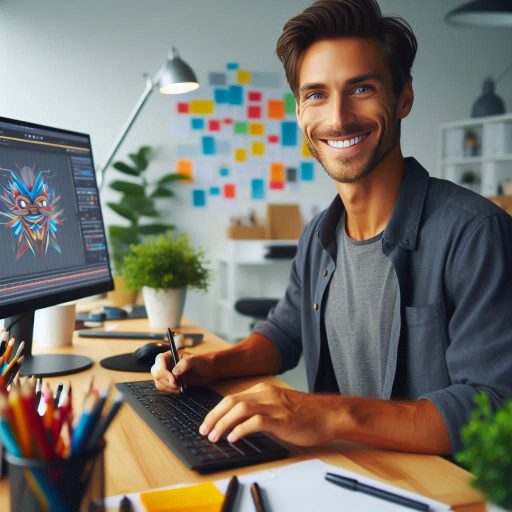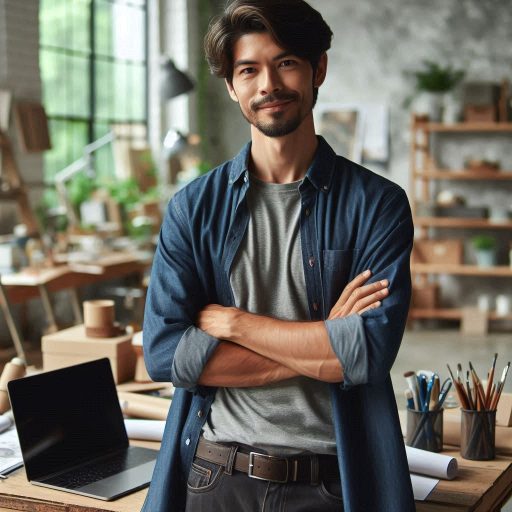Introduction
3D digital art is a rapidly growing form of artistic expression that uses computer software to create three-dimensional images.
As technology advances, more and more artists are turning to this medium to bring their creative visions to life.
Getting started with 3D digital art offers numerous benefits.
It provides artists with a new way to explore their creativity, allowing them to sculpt, texture, and light their creations in a virtual space.
Additionally, 3D digital art offers endless opportunities for collaboration and experimentation.
Research and Inspiration
Research different styles and techniques of 3D digital art
When you are getting started with 3D digital art, it is important to do your research and gather inspiration from various sources.
By exploring different styles and techniques, you can expand your knowledge and improve your skills in this digital medium.
Start by researching the different styles and techniques that artists use in 3D digital art.
Look at how they create depth, texture, and lighting in their designs.
This can help you understand the possibilities of what you can achieve with 3D digital art.
Look for inspiration from other artists and online resources
Next, seek inspiration from other artists and online resources.
Visit websites, social media platforms, and digital art forums to see what other artists are creating.
Pay attention to the details in their work and consider how you can incorporate similar aspects into your own art.
Create a mood board or Pinterest board to gather ideas
One effective way to gather and organize your ideas is by creating a mood board or Pinterest board.
This can be a collection of images, color palettes, textures, and references that inspire you.
Use this board as a visual guide to help you stay focused and motivated during your art-making process.
Overall, research and inspiration are essential steps in getting started with 3D digital art.
They can help you develop your artistic style, improve your technical skills, and ignite your creativity.
Read: The Future of Digital Art: What to Expect
Choose the Right Software
When it comes to creating 3D digital art, choosing the right software is crucial for your success.
Transform Your Career Today
Unlock a personalized career strategy that drives real results. Get tailored advice and a roadmap designed just for you.
Start NowHere are some tips to help you get started:
Explore Different Software Options
- Look into popular choices such as Blender, Maya, or ZBrush.
- Research each software’s capabilities and user-friendly interface.
- Consider your budget and the specific features you need for your projects.
Choose the Right Program
- Start with a beginner-friendly program to build your skills and confidence.
- Once you feel more comfortable, you can explore more advanced tools.
- Don’t be afraid to experiment with different software to find what works best for you.
By following these steps, you can set yourself up for success in the world of 3D digital art.
Remember, practice makes perfect, so don’t be afraid to keep learning and growing as an artist!
Read: The Role of Feedback in Improving Character Designs
Learn the Basics
Before diving into the world of 3D digital art, it is essential to learn the basics.
This foundation will set you up for success and help you progress in your artistic journey.
Here are some key steps to get started:
Familiarize Yourself with the Interface and Tools
Every 3D digital art software has its own unique interface and set of tools.
Before you start creating, take some time to explore the software and understand where everything is located.
Familiarizing yourself with the interface will make it easier to navigate and work efficiently.
Start with Simple Tutorials and Exercises
One of the best ways to learn the fundamentals of 3D digital art is by following tutorials and completing exercises.
These resources are designed to introduce you to the basic concepts and techniques used in 3D art.
They will help you understand how to create 3D models, apply textures, and render images.
Practice Creating Basic Shapes and Objects
Once you have a good grasp of the software and its tools, start practicing by creating basic shapes and objects.
This will help you hone your skills and get comfortable with the process of 3D modeling.
Experiment with different shapes, sizes, and textures to explore the possibilities of 3D art.
By learning the basics, familiarizing yourself with the software, and practicing regularly, you will be on your way to mastering the art of 3D digital art.
Remember, patience and persistence are key when starting out.
Embrace the learning process and have fun exploring the endless creative possibilities that 3D art has to offer!
Showcase Your Business Today
Reach thousands of readers actively exploring professional services. Publish your business profile and grow your audience now.
Publish NowRead: Managing Time as a Freelance Digital Artist

Experiment and Practice
Diving into 3D digital art can be thrilling, and experimenting and practicing is key to mastering it.
Here’s how you can make the most out of this phase:
Try out different techniques and styles to find what works best for you
Experiment with various techniques to discover what suits you best.
Start with basic modeling techniques like box modeling or sculpting.
Explore different styles such as realistic, abstract, or cartoonish.
Each technique offers unique advantages and challenges.
By trying diverse methods, you’ll gain a broader understanding of what works for you and what doesn’t.
Don’t be afraid to mix techniques to create something new and exciting.
Create your own projects and experiment with textures, lighting, and rendering
Once you’re familiar with the basics, start creating your own projects.
Design simple objects or scenes that interest you.
Focus on experimenting with textures, lighting, and rendering to see how they affect your work.
Textures can add depth and realism to your models.
Experiment with different lighting setups to change the mood and visibility.
Try various rendering settings to understand how they impact the final output.
Personal projects allow you to apply what you’ve learned and push your boundaries.
Practice regularly to improve your skills and develop your own unique style
Regular practice is essential to improving your skills.
Set aside time each week to work on 3D art projects.
The more you practice, the better you’ll become.
Create a habit of working on new challenges and refining your techniques.
Consistent practice helps you develop your own unique style and make faster progress.
Don’t be discouraged by mistakes; they are part of the learning process.
By experimenting with techniques, creating personal projects, and practicing regularly, you’ll steadily enhance your 3D digital art skills and find your own artistic voice.
Read: How to Balance Detail and Simplicity in Characters
Join Online Communities
Connecting with Other Artists
One of the best ways to get started with 3D digital art is to join online communities.
These communities provide a support system and a wealth of knowledge that can help you grow as an artist.
Utilize Online Forums and Social Media Groups
There are numerous online forums and social media groups dedicated to 3D digital art.
These platforms allow you to connect with artists from around the world, share your work, ask for feedback, and learn from experienced professionals.
Benefits of Joining Online Communities
By joining online communities, you have the opportunity to network with other artists, collaborate on projects, and gain valuable insights into the industry.
This networking can lead to new opportunities and help you improve your skills.
Collaborating with Other Artists
Collaboration is a great way to enhance your skills and gain practical experience in 3D digital art.
Working with other artists can help you learn new techniques, get feedback on your work, and expand your creative horizons.
Sharing Knowledge and Experience
When you collaborate with other artists, you have the chance to share your knowledge and experience with each other.
This exchange of ideas can help you grow as an artist and improve your overall skills.
Improving Your Skills Through Collaboration
Collaborating with other artists on projects allows you to see how different artists approach the same task.
This exposure to different styles and techniques can help you develop your own unique artistic style and improve your skills.
By joining online communities and collaborating with other artists, you can enhance your skills, learn from experienced professionals, and expand your creative horizons in the world of 3D digital art.
Take Online Courses or Workshops
Advantages of Taking Online Courses or Workshops
Online courses and workshops have become increasingly popular for those looking to develop their skills in 3D digital art.
Here are some benefits:
- Convenience: Online courses allow you to learn at your own pace and from the comfort of your own home.
This flexibility is ideal for those with busy schedules. - Access to Industry Professionals: By enrolling in online courses, you have the opportunity to learn from experienced professionals in the field who can provide valuable insights and feedback.
- Cost-Effective: Online courses are often more affordable than traditional in-person classes, making it a cost-effective option for those looking to learn 3D digital art on a budget.
- Networking Opportunities: Online courses and workshops provide a platform to connect with other aspiring artists and industry professionals, allowing you to build a network within the 3D digital art community.
- Continuous Learning: With the variety of courses available online, you can continuously improve your skills and knowledge in 3D digital art by exploring different topics and techniques.
Tips for Making the Most of Online Courses or Workshops
Here are some tips to help you maximize your learning experience when taking online courses or workshops:
Showcase Your Business Today
Reach thousands of readers actively exploring professional services. Publish your business profile and grow your audience now.
Publish Now- Set Clear Goals: Define what you want to achieve from the course and set specific goals to keep yourself motivated and focused throughout the learning process.
- Engage Actively: Participate in discussions, ask questions, and interact with instructors and fellow students to make the most of the online learning environment.
- Practice Regularly: Apply the knowledge and techniques you learn in the course by practicing regularly to improve your skills and build a strong portfolio.
- Seek Feedback: Don’t be afraid to seek feedback from instructors and peers to identify areas for improvement and refine your work.
- Stay Updated: Keep up-to-date with the latest trends and advancements in 3D digital art by exploring additional resources and attending workshops or webinars.
By taking advantage of online courses and workshops, you can enhance your skills, expand your knowledge, and advance your career in the exciting world of 3D digital art.
Conclusion
After discussing the key points in this blog post, it is clear that getting started with 3D digital art requires dedication and practice.
If you are interested in exploring the world of 3D digital art, I encourage you to follow your passion and start creating.
Remember to start with the basics, such as learning software and tools, practicing regularly, and seeking feedback from others.
Don’t be afraid to experiment and try new techniques, as this is essential for growth and improvement in 3D digital art.
Lastly, surround yourself with a supportive community of fellow artists and continue to push yourself to learn and evolve in your craft.
With dedication and perseverance, you can create incredible works of art in the exciting world of 3D digital art.
[E-Books for Sale]
The Big Book of 500 High-Paying Jobs in America: Unlock Your Earning Potential
$19.99 • 500 High-Paying Jobs • 330 pages
Explore 500 high-paying jobs in America and learn how to boost your career, earn more, and achieve success!
See All 500 High-Paying Jobs of this E-Book
1001 Professions Without a Degree: High-Paying American Jobs You Can Start Now
$19.99 • 1001 Professions Without a Degree • 174 pages
Discover 1001 high-paying jobs without a degree! Unlock career tips, skills, and success strategies for just $19.99!




